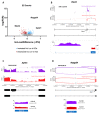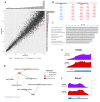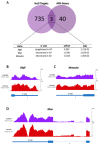The RNA-Binding Protein HuD Regulates Alternative Splicing and Alternative Polyadenylation in the Mouse Neocortex
- PMID: 34064652
- PMCID: PMC8151252
- DOI: 10.3390/molecules26102836
The RNA-Binding Protein HuD Regulates Alternative Splicing and Alternative Polyadenylation in the Mouse Neocortex
Abstract
The neuronal Hu/ELAV-like proteins HuB, HuC and HuD are a class of RNA-binding proteins that are crucial for proper development and maintenance of the nervous system. These proteins bind to AU-rich elements (AREs) in the untranslated regions (3'-UTRs) of target mRNAs regulating mRNA stability, transport and translation. In addition to these cytoplasmic functions, Hu proteins have been implicated in alternative splicing and alternative polyadenylation in the nucleus. The purpose of this study was to identify transcriptome-wide effects of HuD deletion on both of these nuclear events using RNA sequencing data obtained from the neocortex of Elavl4-/- (HuD KO) mice. HuD KO affected alternative splicing of 310 genes, including 17 validated HuD targets such as Cbx3, Cspp1, Snap25 and Gria2. In addition, deletion of HuD affected polyadenylation of 53 genes, with the majority of significantly altered mRNAs shifting towards usage of proximal polyadenylation signals (PAS), resulting in shorter 3'-UTRs. None of these genes overlapped with those showing alternative splicing events. Overall, HuD KO had a greater effect on alternative splicing than polyadenylation, with many of the affected genes implicated in several neuronal functions and neuropsychiatric disorders.
Keywords: Elavl4 KO; HuD; alternative polyadenylation; alternative splicing; neocortex.
Conflict of interest statement
The authors declare no conflict of interest.
Figures








Similar articles
-
HuD regulates SOD1 expression during oxidative stress in differentiated neuroblastoma cells and sporadic ALS motor cortex.Neurobiol Dis. 2021 Jan;148:105211. doi: 10.1016/j.nbd.2020.105211. Epub 2020 Dec 1. Neurobiol Dis. 2021. PMID: 33271327
-
RNA-Binding Proteins HuB, HuC, and HuD are Distinctly Regulated in Dorsal Root Ganglia Neurons from STZ-Sensitive Compared to STZ-Resistant Diabetic Mice.Int J Mol Sci. 2019 Apr 22;20(8):1965. doi: 10.3390/ijms20081965. Int J Mol Sci. 2019. PMID: 31013625 Free PMC article.
-
Promotion of exon 6 inclusion in HuD pre-mRNA by Hu protein family members.Nucleic Acids Res. 2010 Jun;38(11):3760-70. doi: 10.1093/nar/gkq028. Epub 2010 Feb 16. Nucleic Acids Res. 2010. PMID: 20159993 Free PMC article.
-
Emerging complexity of the HuD/ELAVl4 gene; implications for neuronal development, function, and dysfunction.RNA. 2013 Aug;19(8):1019-37. doi: 10.1261/rna.039164.113. RNA. 2013. PMID: 23861535 Free PMC article. Review.
-
Role of HuD in nervous system function and pathology.Front Biosci (Schol Ed). 2013 Jan 1;5(2):554-63. doi: 10.2741/s389. Front Biosci (Schol Ed). 2013. PMID: 23277068 Review.
Cited by
-
Dynamic Variations of 3'UTR Length Reprogram the mRNA Regulatory Landscape.Biomedicines. 2021 Oct 28;9(11):1560. doi: 10.3390/biomedicines9111560. Biomedicines. 2021. PMID: 34829789 Free PMC article. Review.
-
Regulation and function of alternative polyadenylation in development and differentiation.RNA Biol. 2023 Jan;20(1):908-925. doi: 10.1080/15476286.2023.2275109. Epub 2023 Oct 31. RNA Biol. 2023. PMID: 37906624 Free PMC article. Review.
-
Evolution of the Neocortex Through RNA-Binding Proteins and Post-transcriptional Regulation.Front Neurosci. 2022 Jan 10;15:803107. doi: 10.3389/fnins.2021.803107. eCollection 2021. Front Neurosci. 2022. PMID: 35082597 Free PMC article. Review.
-
Post-transcriptional mechanisms controlling neurogenesis and direct neuronal reprogramming.Neural Regen Res. 2024 Sep 1;19(9):1929-1939. doi: 10.4103/1673-5374.390976. Epub 2023 Dec 15. Neural Regen Res. 2024. PMID: 38227517 Free PMC article.
-
The molecular genetics of nELAVL in brain development and disease.Eur J Hum Genet. 2023 Nov;31(11):1209-1217. doi: 10.1038/s41431-023-01456-z. Epub 2023 Sep 12. Eur J Hum Genet. 2023. PMID: 37697079 Free PMC article. Review.
References
MeSH terms
Substances
Grants and funding
LinkOut - more resources
Full Text Sources
Molecular Biology Databases
Research Materials
Miscellaneous

